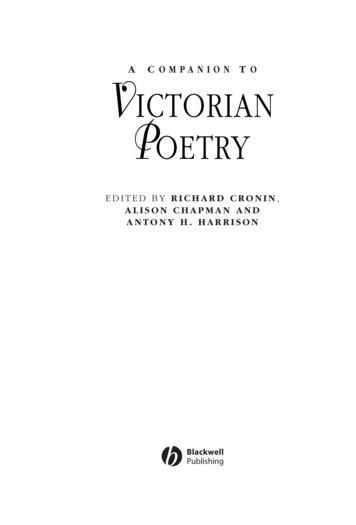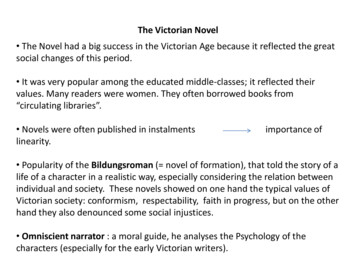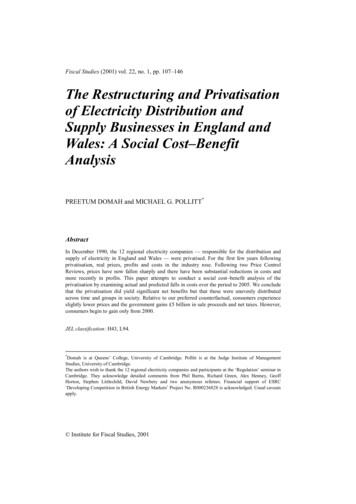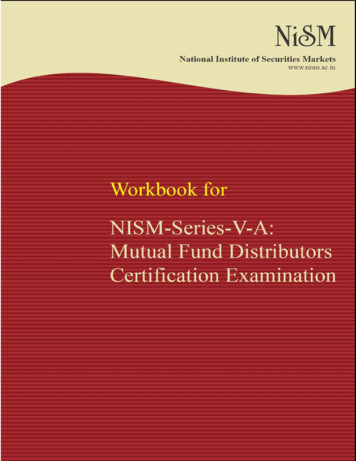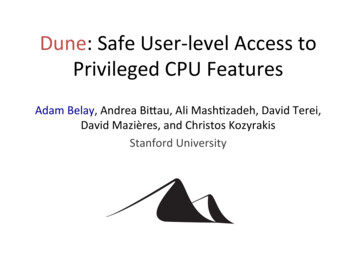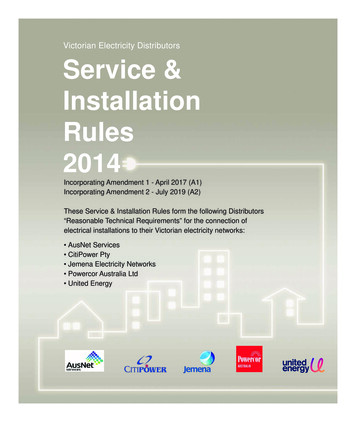
Transcription
Victorian Electricity DistributorsService &InstallationRules2014Incorporating Amendment 1 - April 2017 (A1)Incorporating Amendment 2 - July 2019 (A2)These Service & Installation Rules form the following Distributors“Reasonable Technical Requirements” for the connection ofelectrical installations to their Victorian electricity networks: AusNet Services CitiPower Pty Jemena Electricity Networks Powercor Australia Ltd United Energy
AcknowledgmentThe Victorian Service and Installation Rules ManagementCommittee wishes to thank the following organisations fortheir valuable assistance in the preparation of these rules.Energy Safe Victoria (ESV)National Electrical and Communications Association (NECA)Institute of Electrical Inspectors Australia (IEI)Master Electricians Australia (MEA)A2Clean Energy Council (CEC)
ForewordThe Service & Installation Rules, 2014, have been developed by the VictorianElectricity Distributors Service and Installation Rules Management Committeeand supersede the 2005 edition.A2This edition of the Rules will commence operation on 1 January 2014 andapply to all connections to the electricity supply networks operated by theVictorian Electricity Distributors, namely CitiPower, Jemena ElectricityNetworks, Powercor Australia Ltd, AusNet Services and United Energy.The Rules form the major part of Victorian Electricity Distributors’ “reasonabletechnical requirements” as referred to in the Electricity Distribution Code. TheElectricity Distribution Code is applied under the Electricity Industry Act 2000(Vic) and is administered by the Essential Services Commission Victoria.The Rules have been subject to extensive industry consultation during theirdevelopment and offer users with industry agreed specifications intended toassist Distributors, Retailers, customers and customers’ agents to meet theirregulatory and electricity supply obligations. The Rules lessen the need toreference the complex, extensive and expanding range of regulations anddocumentation relating to connection of installations to Victorian electricitynetworks.A2A2All installations connected, or to be connected, to the Victorian ElectricityDistribution networks shall comply with the Rules as a condition to acquiringand maintaining an electricity supply.The Rules may not cover all circumstances. These may include unusualconnections, inadvertent omissions or changes to legislation and codes. TheVictorian Electricity Distributors SIR Management Committee does not acceptresponsibility where this occurs. The relevant Victorian Electricity Distributorshall be consulted in these circumstances.Peter AllanChairmanVictorian Service and Installation RulesManagement Committee
Section 1GeneralVictorian Service & Installation Rules – Amendment 2 – July 20191-1
General1.1Document Contents SummarySection 11.11.21.31.4A21.5Section 15Section 3GeneralPageDocument Contents -3InnovationObjectiveUsersPublication and RevisionSIR Management Committee ContactDispute Resolution2-32-32-32-42-52-5ScopeApplication & Application ResponsibilitiesFailure to Comply with These RulesExceptional CircumstancesOffencesNecessity for Employing a Licensed PersonBasic Industry Relationship2-52-52-52-62-62-72-7Distribution Areas and Contact DetailsVictorian Distribution CompaniesCitiPowerJemena Electricity NetworkPowercor AustraliaAusNet ServicesUnited EnergyA1Section 44.11-2Supply Application, Connection & Disconnection4.3Conditions of SupplyNegotiations for Obtaining / Altering an ElectricitySupply and Warning against Premature ExpenditureTypical Connection Process4.44.54.6Application for Supply AvailabilityNotification of Electrical Victorian Service & Installation Rules – Amendment 2 – July 2019
GeneralSection 4FormFormFormFormSection 5Electrical Work Request (EWR)Field Works OrderApplication for Abolishment of Electrical SupplyReconnection of Electricity Supply4-94-104-114-12General RulesSafetyCompliance with Regulations, Codes of Practices andthese Rules5-35-55.35.45.55.65.75.8Equipment AcceptanceLabellingAccess to Distributors’ EquipmentSealing and LockingPrivate Electric Lines on Public LandMultiple Occupancy Buildings and Subdivisions(General)5-65-65-75-75-95-12Supply Types, Use and Protection6.16.2Network SupplyPoint of Supply6-66-76.36.46.56.66.76.86.9Consumer’s TerminalsSupply Arrangement DiagramsSupply Use ObligationsType of Supply and LoadSupply Capacity (Maximum Demand Limitation)Installation & Supply ProtectionSources of Alternative Supply6-96-106-106-136-146-156-21Section 7A2Page5.15.2Section 6A2Supply Application, Connection & DisconnectionConnecting to the Low Voltage (LV) Network7.1Distributor’s LV Network/Electrical ice PitsUnderground Service CablesOverhead ServicesUn-metered Consumer’s Mains & Sub MainsBuilder’s Supply in a Permanent PositionBuilder’s Supply Pole in a Non-Permanent PositionEquipment other than Consumer’s Mains on aDistributor’s PoleElectrical Installations on Public LandMultiple Occupancy Buildings and Subdivisions(Supply orian Service & Installation Rules – Amendment 2 – July 2019 7-417-421-3
GeneralSection 8A2Low Voltage MeteringPage8.18.28.38.4ScopeTariffs & MeteringMetering ObligationsMetering ction against Damage to and Interference withMetering Equipment, and Injury to Persons8-138-148.88.98.10Metering Equipment - Limits of OperationDirect Connected MeteringSpecific Situation Requirements8-168-168-178-218.118.12LV Current Transformer MeteringMetering Communications Equipment8-568-70Section 9 - High Voltage Electrical Installations9.19.29.39.49.5ScopeContractual ArrangementsSystems of SupplyPreliminary InformationInstallation rsion from Low Voltage to High Voltage SupplyGeneral DesignProtectionInsulation Co-ordinationShort Time Withstand CurrentEarthingDistributor’s Acceptance eringTesting and CommissioningCustomer’s HV Installation Operation and Maintenance9-119-199-19Appendix A1-4Considerations for High Voltage InstallationsVictorian Service & Installation Rules – Amendment 2 – July 2019
General1.2ReferencesThe following list of reference documents and organisations have been compiled forinformation purposes only. The documents and organisations referred to within the tableare considered current at the time of publication of these rules. As these references aresubject to change, it is the users’ responsibility to confirm the particular organisations ordocuments referenced are current.Acts include: Regulations include:Electricity Industry Act 2000Electricity Safety Act 1998Essential Services Commission Act 2001National Electricity (Victoria) Act 2005Occupational Health & Safety Act 2004Trade Practices Act 1974 (Cth)Owners Corporation Act 2006Electricity Safety: (Installations) Regulations 2009 (Management) Regulations 2009 (Electric Line Clearance) (2010) (Bushfire Mitigation) Regulations 2003 (Cathodic Protection) Regulations 2009Orders and licenses provided by the Regulators under the Acts include: Orders in Council made under the Acts Licences issued to Distributors and Retailers by the ESC under the Electricity Industry ActStatements, Codes and Guidelines published by Regulators under the Acts include: National Electricity RulesElectricity Distribution CodeElectricity System CodeElectricity Retail CodeElectricity Customer Metering CodePublic Lighting CodeVESI Metrology ProcedureGuidelines published by the ESC Codes of Practice and Guidelines published byESV No Go Zone (Framework for Undertaking WorkNear Overhead and Underground Assets)Codes of Practice: for Safe Electrical Work Low Voltage ElectricalInstallationsOther references include: Distribution Company’s List of Approved ChargesSpecification for Indoor Substation onCustomers PropertyGuide to the Permanent Earthing ofDistribution System AssetsStandards AustraliaCodes of Practice: for Overhead Power and TelecommunicationsIn-span Crossings of Electrical Safety for Work on or Near HighVoltage Electrical Apparatus (The Blue Book) Shared Use of Poles Code for Low Voltage Fuse Removal and Reinsertion Electrical Installation Regulation ReviewMeeting, NotesReferences Administrators and their Contact Details include:Australian Energy Market Commissionwww.aemc.gov.auAustralian Energy Regulatorwww.aer.gov.auElectricity Retailerswww.esc.vic.gov.au – Licences IssuedEnergy Safe Victoriawww.esv.vic.gov.auEssential Services Commissionwww.esc.vic.gov.auAustralian Energy Market Operatorwww.aemo.com.au/Standards Australiawww.standards.org.auVictorian Electricity Distributors– See Section 3 of these Rules.Victorian WorkCover Authoritywww.workcover.vic.gov.auVictorian Electricity Supply Industrywww.vesi.com.au/Victorian Service & Installation Rules – Amendment 2 – July 2019 1-5
General1.3DefinitionsThe definitions contained herein apply to these Service & Installation Rules and may varyfrom definitions contained in other documents.Accessible, readily - has the same meaning as it has in the Australian/New ZealandWiring RulesA2Advanced Metering Infrastructure (AMI) – The infrastructure associated with theinstallation and operation of electricity metering and communications including intervalmeters designed to transmit data to and receive data from a remote locality.Allocated Maximum Demand – the demand of the electrical installation as assessed bythe Responsible Officer and specified in writing.Authorised Person – the person in charge of the premises, or the registered electricalcontractor or licensed electrical installation worker or other person appointed or selectedby the person in charge of the premises, to perform certain duties associated with theelectrical installation on the premises, as defined in the Wiring RulesBattery Energy Storage System (BESS) - Consists of Power Conversion Equipment(PCE), battery system(s), protection devices and all the necessary additional equipment.(Examples include d.c./a.c., inverters, d.c./d.c. converters, charge controllers, etc)Certificate of Electrical Safety (CoES) - a certificate of compliance as required by theElecricty Safety Act for electrical installation work carried out by a licensed electricalinstallation workerA2Child – A child metering point is a metering point which has a relationship to a parentmetering point such that the arithmetical difference between the energy measured at theparent metering point and the child metering point represents the energy consumption forone or more other connection points.Common Area – an area within a multiple occupancy premises used by the occupiers ofthe premises and visitors. Note, Common Areas typically become Common Property inthe event a property subdivision occurs.Common Property (CP) – land shown as common property on a plan of subdivision or aplan of strata or cluster subdivision.Consumer’s Mains – The conductors installed between the point of supply/consumer’sterminals and the main switchboard.Consumer’s Terminals – the electrical junction at which the Distributor cable or supplyconductors connect to the customer's installation or consumer's mains within thecustomer's property.Customer – a person or organisation whose electrical installation is connected to theDistributor’s distribution system or who may want to have its electrical installationconnected to the Distributor’s distribution system.Customer Agent/s - Customer agents are parties representing the customers. Such partiesmay include registered electrical contractors, licensed electrical workers, licensedelectrical inspectors, consulting engineers, architects, and equipment manufacturers.Deemed - regarded, considered or judged.A1Deemed Distribution Contract – as defined in the Electricity Distribution Code.1-6Victorian Service & Installation Rules – Amendment 2 – July 2019
GeneralDistributor – a person who holds a Distribution Licence, or who is exempted fromholding a licence of the Electricity Industry Act. “Distributor” is also known as the Local Network Service Provider (LNSP). “relevant Distributor” is the Distributor who operates the Network in the areaassociated with an electrical installation.Distribution Licence – a licence to distribute and supply electricity granted under theElectricity Industry Act.A2Electrical Work Request (EWR) – A notification document as required by Section 4Electricity Distribution Code – the Electricity Distribution Code administered by theEssential Services Commission.Electricity Safety Act 1998 (ESA) - The Act is to make further provision relating to—(a) the safety of electricity supply and use; and(b) the reliability and security of electricity supply; andA2(c) the efficiency of electrical equipment.Electricity Safety (Installations) Regulations 2009 (ES(I)R) – Regulations prescribedby the Electricity Safety ActElectrical Installation – The consumer’s terminals, their enclosure, and all wiring andequipment downstream and supplied from those terminals, except for the Distributor’snetwork assets and where applicable, the metering assets.An electrical installation does not include Distributors network assets including: The meter equipment located within an electrical installation including the service anddistribution equipment upstream of the consumer’s terminals. The Network assets on land occupied by a Distributor that are not used for theconsumption of electricity on that land or incidental to that consumption. Fuse cartridges for a Supply Protection Device and/or Occupancy DisconnectionDeviceEmbedded generator - Any electrical energy source that can connect to the distributionnetwork.Embedded Network (EN) – An embedded network is a distribution network which has aconnection point to another distribution network and does not have a connection point toa transmission network.Embedded Network Manager (ENM) - is a service provider accredited by theAustralian Energy Market Operator (AEMO). The purpose of the ENM is to facilitate thetransfer of a customer from off-market to on-market (and back again if required).Embedded Network Operator (ENO) – Although not a registered participant in theNational Electricity Market, a person or body that is responsible for and authorised by therelevant Regulators, to operate an electrical installation with multiple electricitycustomers, and to convey electricity through the electrical installation of the person orbody after the electricity leaves a supply facility owned or operated by a distributioncompany and before being supplied to the customer.A2Embedded Network Operator Customer (ENOC) – A customer within and connectedto an ENO electrical installation that chooses to purchase electrical energy from theEmbedded Network Operator rather than the National Electricity Market.Field Works Order (FWO) - Where the Customer or Customers agent who requestsDistributor work to take place and re-assigns Distributor charges to another party.Victorian Service & Installation Rules – Amendment 2 – July 2019 1-7
GeneralHigh Voltage (HV) - has the same meaning as it has in the Australian/New ZealandWiring RulesInverter Energy System (IES) – has the same meaning as it has in AS/NZS 4777 SeriesLEI – Licensed Electrical InspectorLEIW – Licensed Electrical Installation WorkerLicensed electrician – an Licensed Electrical Installation Worker (LEIW) holding anelectrician’s licence under Part 3 of the Electricity Safety (Registration and Licensing)Regulations.Local Network Service Provider (LNSP) is the distribution network provider that isnormally adjacent to the embedded network.Low Voltage (LV) - has the same meaning as it has in the Australian/New ZealandWiring RulesMetering Code – the laws, codes or other regulatory instruments about metrologyapplicable to a particular customer which may include one or more of the:(a) National Electricity Rules;(b) Metrology Procedure; and(c) Electricity Customer Metering Code.These documents cover Embedded Network metering for the Parent and Child metertypes, accuracy, maintenance, records and responsibilities and stipulates that the ParentMeter shall be an Interval meter. The LNSP will provide metering to NEMC child supplypoints less than 160MWh as required by the expiry of derogation from the NER inVictoria.Metering Coordinator (MC) - is a registered participant role within the NationalElectricity Market (NEM), with the overall responsibility for metering services at acustomer's connection point within a distribution or transmission systemA2Metering Marshalling Point (MMP) – the location where the wiring from the highvoltage current and voltage transformers terminate behind the meter panel.Metering Provider (MP) – A person who meets the requirements listed in the NationalElectricity Rules and has been accredited by and registered by AEMO as a MeteringProvider.Metering Terminal Point (MTP) – the location where the wiring from the high voltagecurrent and voltage transformers terminate in the LV area of the high voltage switchboardNational Electricity Market Customer (NEMC) is a customer who is allocated aNational Metering Identifier (NMI), and purchases electrical energy through the NationalElectricity Market from a licensed electricity Retailer.Occupancy – an electrical installation or part thereof, which is supplied with electricitythrough a specific meter or meters and for which an individual electricity consumptionaccount is rendered.Occupancy Disconnection Device (ODD) – A device provided for the purpose ofdisconnection and reconnection of individually metered occupancies within multipleoccupancy premises.Occupancies Multiple or Multiple Occupancies – more than one Occupancy connectedto the same electrical installation.Owners Corporation (OC) – a body corporate which is incorporated by registration of aplan of subdivision or a plan of strata or cluster subdivision;1-8Victorian Service & Installation Rules – Amendment 2 – July 2019
GeneralParent Metering Point – A parent metering point is a metering point through which theenergy measured is supplied to more than one connection point.Point of Attachment (POA)– The point at which an overhead aerial service cable isattached.Point of Supply (POS) – the point at which the electricity Distributors service cable orsupply main connects to the consumer’s terminals. Refer to Section 6 (Point of Supply).(The Electricity Safety Act regulates Points of Supply locations)Private Electric Line (PEL) – has the same meaning as the ES Act.Private Aerial Line (PAL) – has the same meaning as the ES Act.Property – “Property” is defined in clause 6.2 (Point of Supply).Public Land – “Public Land” is defined in Section 5 (Private Electric Lines in PublicLand)REC – Registered Electrical Contractor.Readily Accessible – See Accessible, ReadilyResponsible Officer (RO) – the officer appointed by the relevant Distributor to beresponsible for the administration of these Rules.Dependent on a Distributor’s structure, there may be multiple Responsible Officers withspecific responsibilities, eg, negotiation for supply, provision of substations, specificationof points of supply, types of supply, servicing and metering etc.Retailer – a holder of a Retail Licence, or a person who has been exempted from therequirement to obtain a Retail Licence under the Electricity Industry Act.Retail Licence – a licence to sell electricity otherwise than through the Pool grantedunder the Electricity Industry Act.A2Service Cable / Line – the final span or section of a Distributor’s low voltage aerial orunderground network asset that is connected to the consumer’s terminals.Service Connection Facility (SCF) – A facility containing consumer’s terminalsprovided for the connection of a Distributor’s service cable, eg, pillar, cubicle,switchboard or CT enclosure.Service Equipment – equipment owned by the Distributor and used to connect supply toan Electrical InstallationShall – is to be understood as mandatory.Should – is to be understood as a recommendationSubdivision – the division of land into two or more parts which can be disposed ofseparately.Suitable (or suitably) – to the satisfaction of the Distributor’s Responsible Officer.Supply, Alternative - A supply system intended to maintain the functioning of anelectrical installation or a part or parts thereof, in case of interruption of the normalsupply.Supply Capacity Control Device (SCCD)– a device other than a fuse cartridge to limitthe maximum demand of an Electrical Installation as per Section 6 of these rulesSupply, Normal - The source of supply that the electrical installation is supplied fromunder normal conditions of operation.NOTE: The normal supply is usually from a distribution network, but may instead befrom a generation systemVictorian Service & Installation Rules – Amendment 2 – July 2019 1-9
GeneralSupply Protection Assembly (SPA) - assembly for the purpose of accommodating theSupply Protection Device eg; Fused Overhead Line Connector Box, Panel Mounted Fuseor Fused Switch DisconnectorSupply Protection Device (SPD) – a device required by the Electricity Safety(Installations) Regulations and Section 6 of these Rules.Supply, Supplementary - A supply system intended to operate in conjunction with thenormal supply.Uninterruptible Power Supply (UPS) – A combination of convertors, switches andenergy storage devices (for example batteries) constituting a power system formaintaining continuity of load power in case of input power failure.Wiring Rules – the Wiring Rules published by Standards Australia as applied under theElectricity Safety Act and Regulations.1.4AbbreviationsACB – Air Circuit BreakerAEMO – Australian Energy Market OperatorAER – Australian Energy RegulatorAMI – Advanced Metering InfrastructureBESS – Battery Energy Storage SystemCB – Circuit BreakerCFA – Country Fire AuthorityCoES - Certificate of Electrical SafetyCP – Common PropertyA2CT – Current TransformerEN – Embedded NetworkENO – Embedded Network OperatorENOC – Embedded Network Operator CustomerENM – Embedded Network ManagerESA - Electricity Safety Act 1998ESC – Essential Service CommissionES(I)R - Electricity Safety (Installations) Regulations 2009ESV – Energy Safe VictoriaEWR - Electrical Work RequestFOLCB – Fused Overhead Line Connector BoxFSD – Fused Switch DisconnectorFWO - Field Works OrderHV - High VoltageIES – Inverter Energy SystemLEI – Licensed Electrical InspectorLEIW – Licensed Electrical Installation WorkerLNSP – Local Network Service Provider1-10Victorian Service & Installation Rules – Amendment 2 – July 2019
GeneralLPG - Liquid Petroleum GasLV - Low VoltageMC – Metering CoordinatorMCB – Miniature Circuit BreakerMCCB – Moulded Case Circuit BreakerMEN – Multiple Earthed NeutralMMP - Metering Marshalling PointMP - Metering ProviderMSATS – Metering Settlement and Transfer SolutionMTP - Metering Terminal PointNEM - National Electricity MarketNEMC – National Electricity Market CustomerNER – National Electricity RulesNGZ – No Go ZoneNMI – National Metering IdentifierODD - Occupancy Disconnection DeviceO/H - OverheadOC - Owners CorporationPOA - Point of AttachmentPOS - Point of SupplyA2PEL - Private Electric LinePAL - Private Aerial LinePVC - Polyvinyl ChlorideU/G - UndergroundUPS – Uninterruptible Power SupplyREC – Registered Electrical ContractorRO - Responsible OfficerSFC - Service Connection FacilitySCCD - Supply Capacity Control DeviceSPA – Supply Protection AssemblySPD - Supply Protection DeviceSWER – Single Wire Earth ReturnSWL – Safe Working LoadUPS - Uniteruptable Power SupplyVESI – Victorian Electricity Supply IndustryVPI – Victorian Power IndustryVSIR – Victorian Service & Installation RulesXLPE - Cross-linked PolyethyleneVictorian Service & Installation Rules – Amendment 2 – July 2019 1-11
NERATORSWITCHDISCONNECTORPV ARRAYCIRCUIT BREAKERINVERTERFUSED SWITCHDISCONNECTORBATTERYINTERLOCKEDCHANGEOVER SWITCHSINGLE PHASEFUSETWO PHASERCDTHREE PHASEEARTH OR NEUTRALBAREARTH1-12Victorian Service & Installation Rules – Amendment 2 – July 2019
Section 2IntroductionVictorian Service & Installation Rules – Amendment 2 – July 20192-1
Introduction2-2Section 2 – 6.3Figure 2.6-A2.72.8Publication and RevisionAdministrationPublicationRevisionRevision ProcessSIR Management Committee ContactDispute 2.142.15ScopeApplication & Application ResponsibilitiesFailure to Comply with These RulesExceptional CircumstancesOffencesNecessity for Employing a Licensed PersonBasic Industry Relationship2-52-52-52-62-62-72-72.15.1Figure keholdersElectricity Customer Metering Code stomer Agents2-72-82-82-92-92-92-9Victorian Service & Installation Rules – Amendment 2 – July 2019
Introduction2.1DisclaimerThese Rules have been published by CitiPower, Jemena Electricity Networks, PowercorAustralia, AusNet Services and United Energy. The document has been compiled usingdrawings, guidelines and information that comply with the relevant Acts and Regulationsof the State of Victoria at the date of publication. It is the responsibility of the end user todetermine the suitability of material contained herein to the particular application orpurpose of which it is used. Electricity supply publications are revised when necessary bythe issue of either revised pages or complete new editions. It is important that users ofsuch publications ascertain they are in possession of the latest issue.A1A2WARNING: Printed copies of this document may not be the latest. The most up to dateversion is located on the VSIR website. www.victoriansir.org.auCitiPower, Jemena Electricity Networks, Powercor Australia, AusNet Services andUnited Energy each expressly disclaim any liability, joint or several, to anyone including,without limitation, any end-user of this document, in respect of anything done by them inreliance in whole or in part upon the contents of this document.2.2CopyrightCOPYRIGHT 2013 CitiPower, Jemena Electricity Networks, Powercor Australia,AusNet Services and United Energy.A1All rights are reserved, although the above Distributors will not object to the reproductionor copying of this document or sections of the document for the purpose of education orenhancing the Rules application.However, no part of this document may be reproduced or copied for financial gain in anyform without first obtaining the express written permission of the Service and InstallationRules Management Committee on behalf of CitiPower, Jemena Electricity Networks,Powercor Australia, AusNet Services and United Energy.A1Inquiries concerning copyright should be directed to the Rules Management Committee.2.3InnovationThese Rules do not preclude other methods, innovation, or technology that achieves thesame outcomes as the specifications detailed in this document. Any such proposal shouldbe put to the relevant Distributor or the Rules Management Committee for acceptanceprior to commencement of work.2.4ObjectiveThe objective of these Rules is to provide Victorian electricity customers with industryagreed Distributor reasonable technical requirements (Rules) that meet all legislative andcode requirements for the supply and metering related aspects of any connection to theVictorian electricity supply networks.This is intended to result in significant economies of scale and industry efficiencies due torelatively consistent application of common electricity supply Rules across Victoria.2.5UsersThe main users of this document are Distributors and Retailers, their customers, thecustomer’s agents, and associated industry parties and personnel.These include registered electrical contractors, licensed electrical workers, licensedelectrical inspectors, consulting engineers, architects, electricity Distributor’s personnel,electricity Retailer’s personnel, Metering Providers, equipment manufacturers,representative organisations such as unions, associations, training providers and students,Victorian Service & Installation Rules – Amendment 2 – July 2019 2-3
Introductionthe industry ombudsman, and other persons associated with the connection of customerelectrical installations to electricity supply networks.2.6Publication and Revision2.6.1AdministrationThe revision, development and publication of these Rules is administered by theVictorian Service and Installation Rules Management Committee. The committeecomprises of representatives from CitiPower, Jemena Electricity Networks, PowercorAustralia, AusNet Services and United Energy.Committee advisers at the time of publication include representatives from Energy SafeVictoria, Institute of Electrical Inspectors, the National Electrical and CommunicationsAssociation and Master Electricians & the Clean Energy Council.A22.6.2PublicationThe Victorian Service and Installation Rules were first published in 1987 by the SECVand Local Government Electricity Suppliers. Amended rules were published in 1988,1991 and 1994 by those authorities. Additional amendments were made in 1996, 1999,2001, 2003 and 2005 by electricity Distributors CitiPower, Jemena Electricity Networks,Powercor Australia, AusNet Services and United Energy and their predecessors. Thisedition is applicable from 1 January 2014 with subsequent amendments (A1) April 2017and (A2) July 2019.A22.6.3RevisionAlthough changes to regulations are usually the catalyst for revisions, users and interestedparties are invited to provide comment and suggestions to assist further de
National Electrical and Communicatio ns Association (NECA) . Clean Energy Council (CEC) A2 . Foreword The Service & Installation Rules, 2014, have been developed by the Victorian Electricity Distributors Service and Installation Rules Management Committee . technical requirements" as referred to in the Electricity Distribution Code. The .



